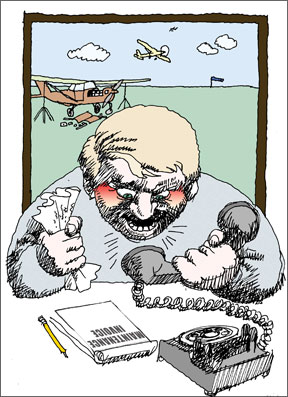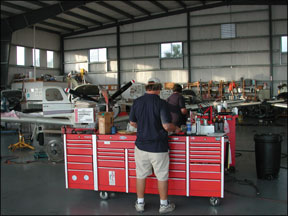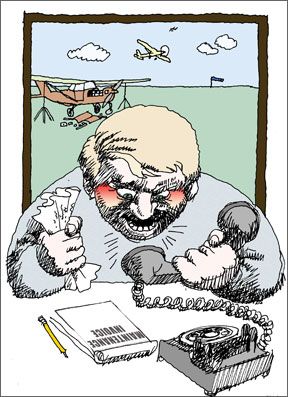Although pilot training provides the knowledge and experience we need to safely fly an aircraft per the regulations, little more than the school of hard knocks is offered to help us maintain it. Amid stories of five-figure annual inspections for piston singles, the typical aircraft owner faced with a maintenance-related decision is more likely to defer to the shop than to seek a professional second opinion. That can get expensive. And, until now, professional maintenance management-that is, having a professional make these decisions on the owners behalf-simply wasnt available for personal aircraft at any cost.
But is there even a market for such a thing? Mike Busch thinks there is. Busch is long-time maintenance advisor to the Cessna Pilots Association, the FAAs National Aviation Maintenance Technician of the Year for 2008 and founder of the Savvy Aviator Seminars on aircraft ownership. In mid-2008, he founded Savvy Aircraft Maintenance Management (SAMM) which offers to professionally manage the scheduled and unscheduled maintenance of most models of owner-flown aircraft.

This service strikes us as moderately priced and the company bills it as a service that will pay for itself by saving owners money. Is it worth it? Our contacts with early clients of SAMM indicate that theyre pleased with the service and seeing reduced maintenance expenses, along with increased confidence.
What SAMM Is
Savvy Aircraft Maintenance Management brings to owner-flown aircraft what previously was available only to the bizjet set. One way to think of SAMMs service, according to Busch, is as a technical interface with the service centers and mechanics doing the work. This sort of professional maintenance management has long been standard for corporate jets and turboprops, but has never been available for owner-flown aircraft, at least that we know of.
In the March, 2005 issue of Aviation Consumer, we reported on a service called Fast Fix pitched as a kind of AAA for pilots, for an annual fee. But that service didnt oversee routine maintenance, as SAMM proposes to do, nor did it handle such tasks as upgrades and long-term repairs.
For a fixed annual fee that varies with aircraft complexity-presently $500 for a legacy fixed-gear single (Skyhawk, Dakota, Cessna 206), $750 for a retractable or technically-advanced single (Bonanza, Cirrus), $1000 for a piston twin and $2000 for single-engine VLJs-SAMM will manage all of your aircrafts maintenance.
Instead of actually turning wrenches, SAMM acts as the owners maintenance advisor and advocate to ensure the aircraft receives first-rate maintenance at the lowest possible cost. It handles everything from picking the shop and giving them their marching orders to reviewing and approving the invoice for payment.
SAMM has on staff maintenance experts with years of experience who intervene between the owner and the shop. For efficiency and to establish a paper trail, communication is generally handled by e-mail, which means that shops that arent e-mail conversant may not be on SAMMs horizon. The service can both recommend shops and/or work with a shop the owner prefers.
The program is a logical extension of Buschs successful Savvy Aviator Seminar Series, which helps owners become more conversant with the regulations addressing aircraft ownership, their responsibilities and how to manage the challenges of maintaining something as complex as a personal airplane. “Most owners have no training in maintenance,” Busch told us, a perrenial problem given that the FAA places the regulatory burden of ensuring airworthiness directly on the owner, not the shop doing the work.
Through his seminars, Busch has trained more than 1000 aircraft owners, most of whom he found were uncomfortable in dealing with A&Ps and shops. Even though pilots can be assertive in the cockpit, many owners are outside their comfort zone in dealing with maintenance.

The result, Busch says, is that decisions tend to be made according to the shops view of the world, not the owners. That can get expensive, often for no good reason, he tells us. “I didnt found SAMM to make money,” Busch told us, “but to try to make a difference in the way owner-flown aircraft are maintained. The present maintenance infrastructure for these aircraft is badly broken and we intend to change that.”
Busch told us that its not unusual for shops to specify repairs or inspections that arent specifically necessary, something he says his service pushes back against. It doesnt take much of that to save the customer the cost of the service for a year, says Busch.
What Clients Think
Although SAMM had been in operation for only six months when we spoke to Busch in early December, the company was already managing the maintenance of more than 70 aircraft and adding about one new aircraft a day. Is SAMM saving its clients money? And are they happy with SAMMs service? To find out, we contacted several SAMM clients.
Gordon Feingold, a SAMM client who owns a Cirrus SR22, purchased his airplane in 2003. “While I love the airplane, my enjoyment has been tempered by great variability in the quality and cost of maintenance,” he told us. “I signed up with SAMM just before my airplanes fifth annual inspection and they managed the whole process. My SAMM account manager handled everything and I got my annual done according to the estimate, with no hassle. It was the least expensive annual Ive ever had,” Feingold said.
Another Cirrus owner and SAMM client, Jeff Harris, told us why he decided to engage a third party to help manage his maintenance: “Because I know there is a lot I don’t know. My Cirrus has been a maintenance hog over the past six years, in my opinion. Mike and his crew deal with this stuff every single day and Ive discovered the world of GA is fraught with pitfalls for the unwary.” Does he think the investment in SAMM was a good one? Yes, he says, not just because of the money savings, but also for the peace of mind of not getting screwed by a shop more interested in its bottom line than in the customers.
Before becoming a SAMM client, Steve Carvajal had his Cessna T210s engine hiccup shortly after takeoff. “I cancelled IFR and returned to the airport. There was a Cessna authorized repair facility on site so I chose that shop to effect repairs. Long story short, that shop cost me $3500 and accomplished absolutely nothing. They even threatened to not release my plane to me, mis-interpreting their rights, responsibility and information with regard to the regs.” He posted information about his situation on a Cessna Pilots Association forum, where Busch offered suggestions.
“Busch provided the diagnosis and the answers without even looking at the plane. Through Mike, I was able to get my plane safely home,” Carvajal told us. After SAMM began operations, he was one of the new companys first clients. Shortly thereafter, he flew to Missoula, Montana on vacation. “Ninety miles from Missoula, the alternator on my T210 failed. I landed and called my account manager at SAMM. We selected a shop to perform the repair and I went on to enjoy my vacation. SAMM handled the repair, checked the bill and ensured that my plane was ready to go when I needed to leave. It was a no-brainer for me. They handled everything perfectly.”
Conclusion
In addition to handling scheduled and unscheduled maintenance of covered airplanes for a flat annual fee, SAMM also will coordinate pre-buy inspections along with upgrades of paint, interiors and avionics. Like SAMMs basic management service, pre-buys and upgrades are managed for a modest flat annual fee. As anyone whos tried to manage an upgrade knows, paying someone else to handle the headache might be worth it.
That said, we don’t think managed maintenance is for everyone. For some owners, managing the airplane is the reason for owning it-the tinkering involvement with aviation is more important than the flying. On the other hand, some of SAMMs initial clients seem to be owners who fly a lot and arent interested in the process of dealing with a mechanic, due to lack or time or disposition. For these owners, $750 may be a bargain at twice the price.
SAMMs service doesnt cover every airplane out there-it doesnt manage multi-engine turbines or large aircraft over 12,500 pounds. Buschs claim that SAMM saves clients money by pushing back on unnecessary repairs is confirmed by the owners we interviewed, so we have no reservations in recommending SAMM for owners lacking the time or desire to become expert in managing air craft maintenance and who prefer to let pros do it. In our view, there’s not much risk in trying it for a year or two. Well take another look at this service in a couple of years, after the client base has expanded. For more, contact www.savvymx.com.


